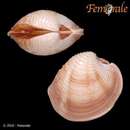Diagnostic Description
provided by FAO species catalogs
Shell solid, equivalve; inequilateral, beaks in the front half of the shell; broadly oval in outline. Ligament a deeply inset, dark brown elliptical band, behind the beaks reaching half-way to the posterior margin. Lunule well defined, broad, heart-shaped. Escutcheon indistinct. Sculpture of concentric lines, raised here and there into ridges, and fine radiating lines. In young specimens the ridges are present all over the shell but in the adult they persist, after wear and tear, only near the anterior and posterior margins. Growth stages prominent. Both valves with three cardinal teeth; in addition there is present in each valve a rough tooth-like area behind the beaks and immediately below the ligament; this area has the appearance of a supplementary posterior cardinal tooth which has been broken off. No laterals. Pallial sinus not deep, triangular. Margin grenulate. Colour a dirty white, light varnish-brown, dull grey or grey-brown. Inside of shell white, sometimes deep violet about the adductor muscle scars.
- Poppe, G.T. & Y. Goto. - 1993European Seashells. Verlag Christa Hemmen, darmstadt, Germany, vol. II: 221 pp.
- Stanley, J. & R. DeWitt. - 1983 Species profiles: life histories and environmental requirements of coastal fishes and invertebrates (North Atlantic) Hard Clam. U.S. Fish and Wildl. Serv. Biol. Rep. 82 (11.18). 19 pp. Tebble, N.- 1966. British Bivalve Seashells. A Handbook for Identification, London Trusties of the British Nuseum (Natural History): 212 pp.
- Turgeon, D.D., A.E. Bogan, E.V. Coan, W.K. Emerson, W.G. Lyons, W.L. Pratt, C.F.E. Roper, A. Scheltema, F.G. Thompson & J.D. Williams. - 1988Common and scientific names of aquatic invertebrates from the United States and Canada: mollusks.
Distribution
provided by FAO species catalogs
Originate from the northeastern American coast from Nova Scotia to Yucatan. It was accidentally introduced into Europe around 1860. Artificilly introduced again around 1950. Now, a few colonies live in the British Isles, The Netherlands, Belgium and France to Atlantic coast of Portugal and Morocco. In the Mediterranean Sea; Sicilie and high Adriatic Sea.
Size
provided by FAO species catalogs
Maximum length is 12,8 cm.
Brief Summary
provided by FAO species catalogs
Euryhaline marine species sensitive to salinities below 12 ppt. Lives in mud, with stones and shells, but prefers muddy bottoms,from the intertidal zone to a depth of 10 m of estuaries or lagoons.Depend on plankton and micro-organisms that are carried along the bottom by currents for food before and during spawning to furnish sufficient energy to ripen the gonads. If the food supply is inadequate, spawning is diminshed or nil.
Benefits
provided by FAO species catalogs
Extensively distributed commercial clam in the United States and have the greatest total market value. Their abundance in clean substrates accessible to the public makes the hard clam a popular recreational species. Caught with dredges and hackles, occasionally with bottom trawls. The total catch reported for this species to FAO for 1999 was 2 536 t. The countries with the largest catches were Canada (2 536 t).

